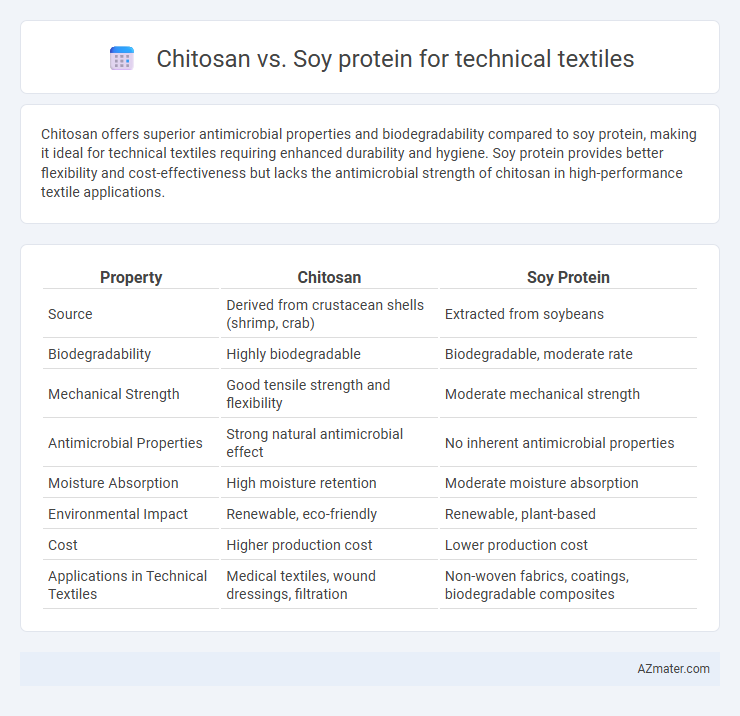Chitosan offers superior antimicrobial properties and biodegradability compared to soy protein, making it ideal for technical textiles requiring enhanced durability and hygiene. Soy protein provides better flexibility and cost-effectiveness but lacks the antimicrobial strength of chitosan in high-performance textile applications.
Table of Comparison
| Property | Chitosan | Soy Protein |
|---|---|---|
| Source | Derived from crustacean shells (shrimp, crab) | Extracted from soybeans |
| Biodegradability | Highly biodegradable | Biodegradable, moderate rate |
| Mechanical Strength | Good tensile strength and flexibility | Moderate mechanical strength |
| Antimicrobial Properties | Strong natural antimicrobial effect | No inherent antimicrobial properties |
| Moisture Absorption | High moisture retention | Moderate moisture absorption |
| Environmental Impact | Renewable, eco-friendly | Renewable, plant-based |
| Cost | Higher production cost | Lower production cost |
| Applications in Technical Textiles | Medical textiles, wound dressings, filtration | Non-woven fabrics, coatings, biodegradable composites |
Introduction to Chitosan and Soy Protein in Technical Textiles
Chitosan, derived from chitin in crustacean shells, offers antimicrobial properties and biodegradability essential for technical textile applications such as wound dressings and filtration materials. Soy protein, extracted from soybeans, provides excellent film-forming ability and biodegradability, making it suitable for technical textiles requiring moisture retention and eco-friendly performance. Both biopolymers contribute to sustainable innovations, with chitosan excelling in antimicrobial functionality and soy protein offering versatile mechanical properties.
Chemical Structure and Properties Comparison
Chitosan is a biopolymer derived from chitin with a linear polysaccharide structure containing glucosamine units, providing inherent antibacterial properties and biodegradability ideal for technical textiles. Soy protein, a natural polymer composed of amino acid chains with diverse functional groups, offers excellent film-forming ability, flexibility, and moisture management but lacks the antimicrobial efficiency of chitosan. The cationic nature of chitosan facilitates strong interactions with anionic textile fibers, enhancing dye affinity and mechanical strength, whereas soy protein's amphiphilic character contributes to hydrophilicity and softness in fabric applications.
Sourcing and Sustainability: Chitosan vs Soy Protein
Chitosan, derived from crustacean shells, offers a sustainable option by utilizing seafood industry waste, reducing environmental impact through biodegradability and renewability. Soy protein, sourced from soybeans, supports plant-based sustainability with a lower carbon footprint and fosters renewable agricultural practices but depends on extensive land and water use. Both materials contribute to eco-friendly technical textiles, with chitosan excelling in waste valorization and soy protein emphasizing renewable plant sourcing.
Processing Techniques for Textile Applications
Chitosan and soy protein exhibit distinct processing techniques suitable for technical textile applications; chitosan is primarily processed via electrospinning, coating, and grafting methods to enhance fiber antimicrobial properties and biocompatibility. Soy protein is typically utilized through film casting, blending with synthetic polymers, and extrusion processes, offering improved biodegradability and mechanical strength in textile composites. Both biopolymers require precise control of parameters such as solvent systems, pH, and drying conditions to optimize fiber morphology and functional performance in technical textiles.
Mechanical Strength and Durability
Chitosan fibers exhibit superior mechanical strength and enhanced durability in technical textiles due to their biopolymer structure and high tensile properties. Soy protein fibers demonstrate moderate mechanical strength but offer excellent biodegradability and flexibility, making them suitable for applications requiring eco-friendly materials with adequate durability. Comparative studies highlight chitosan's advantage in maintaining structural integrity under stress, while soy protein contributes to sustainable textile innovations with balanced performance.
Biodegradability and Environmental Impact
Chitosan exhibits superior biodegradability in technical textiles due to its natural polysaccharide structure, breaking down efficiently into non-toxic components that minimize environmental pollution. In contrast, soy protein fibers biodegrade slower and may release nitrogen compounds, potentially impacting aquatic ecosystems. Utilizing chitosan for technical textiles significantly reduces long-term environmental impact through enhanced decomposition rates and lower ecotoxicity compared to soy protein alternatives.
Functional Properties: Antimicrobial, UV Protection, and More
Chitosan exhibits strong antimicrobial properties and excellent UV protection, making it a preferred biopolymer for enhancing technical textiles' performance in hygiene and outdoor applications. Soy protein offers moderate antimicrobial activity and UV shielding, but its primary advantage lies in biodegradability and mechanical flexibility when applied to textile fibers. Both materials improve moisture management and dye affinity, yet chitosan's superior bioactivity and durability provide a more robust multifunctional finish for advanced technical textiles.
Cost and Commercial Availability
Chitosan, derived from crustacean shells, typically incurs higher production costs due to complex extraction and purification processes, limiting its widespread commercial availability in technical textiles. In contrast, soy protein, sourced from abundant and renewable soybeans, offers a cost-effective and commercially accessible alternative with well-established supply chains. The economic advantage and scalability of soy protein make it more viable for large-scale technical textile applications compared to the more niche, costly chitosan.
Challenges and Limitations in Technical Textile Use
Chitosan faces challenges in technical textile applications due to its limited mechanical strength and moisture sensitivity, which reduce durability and performance under industrial conditions. Soy protein exhibits poor water resistance and thermal stability, leading to degradation and loss of functionality in demanding textile environments. Both materials require chemical modification or blending with synthetic polymers to overcome these limitations and achieve the necessary properties for technical textile use.
Future Trends and Innovations in Bio-based Technical Textiles
Chitosan and soy protein are emerging biopolymers revolutionizing technical textiles through their biodegradability, antimicrobial properties, and sustainable sourcing. Innovations focus on enhancing chitosan's film-forming ability and soy protein's mechanical strength, enabling multifunctional textiles for medical, filtration, and wearable applications. Future trends emphasize nano-engineering and hybrid composites integrating chitosan and soy protein to achieve superior performance, eco-friendly alternatives, and smart textile functionalities.

Infographic: Chitosan vs Soy protein for Technical textile
 azmater.com
azmater.com